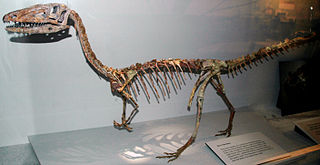
Coelophysis is a genus of coelophysid theropod dinosaur that lived approximately 215 to 208.5 million years ago during the Late Triassic period from the middle to late Norian age in what is now the southwestern United States. Megapnosaurus was once considered to be a species within this genus, but this interpretation has been challenged since 2017 and the genus Megapnosaurus is now considered valid.

Edaphosaurus is a genus of extinct edaphosaurid synapsids that lived in what is now North America and Europe around 303.4 to 272.5 million years ago, during the Late Carboniferous to Early Permian. American paleontologist Edward Drinker Cope first described Edaphosaurus in 1882, naming it for the "dental pavement" on both the upper and lower jaws, from the Greek edaphos έδαφος and σαῦρος ("lizard").
Podokesaurus is a genus of coelophysoid dinosaur that lived in what is now the eastern United States during the Early Jurassic Period. The first fossil was discovered by the geologist Mignon Talbot near Mount Holyoke, Massachusetts, in 1910. The specimen was fragmentary, preserving much of the body, limbs, and tail. In 1911, Talbot described and named the new genus and species Podokesaurus holyokensis based on it. The full name can be translated as "swift-footed lizard of Holyoke". This discovery made Talbot the first woman to find and describe a non-bird dinosaur. The holotype fossil was recognized as significant and was studied by other researchers, but was lost when the building it was kept in burned down in 1917; no unequivocal Podokesaurus specimens have since been discovered. It was made state dinosaur of Massachusetts in 2022.

Elachistosuchus is an extinct genus of neodiapsid reptile, most likely basal archosauromorph, known from the Late Triassic Arnstadt Formation of Saxony-Anhalt, central Germany. It contains a single species, Elachistosuchus huenei, known from a single individual E. huenei, originally considered a pseudosuchian archosaur and then a rhynchocephalian lepidosaur, was largely ignored in the scientific literature, as its small size and fragility did not permit further mechanical preparation and examination. More recently however, a non-invasive μCT scanning was performed to resolve its placement within Reptilia, and found it to represent a more basal reptile, potentially closely related to several early archosauromorph clades.

Ericiolacerta is an extinct genus of small therocephalian therapsids from the early Triassic of South Africa and Antarctica. Ericiolacerta, meaning "hedgehog lizard", was named by D.M.S. Watson in 1931. The species E. parva is known from the holotype specimen which consists of a nearly complete skeleton found in the Lystrosaurus Assemblage Zone within the Katberg Formation of the Beaufort Group in South Africa, and from a partial jaw found in the Lower Triassic Fremouw Formation in Antarctica. Ericiolacerta was around 20 centimetres (7.9 in) in length, with long limbs and relatively small teeth. It probably ate insects and other small invertebrates. The therocephalians – therapsids with mammal-like heads – were abundant in Permian times, but only a few made it into the Triassic. Ericiolacerta was one of those. It is possible that they gave rise to the cynodonts, the only therapsid group to survive into post-Triassic times. Cynodonts gave rise to mammals.

Poposaurus is an extinct genus of pseudosuchian archosaur from the Late Triassic of the southwestern United States. It belongs to the clade Poposauroidea, an unusual group of Triassic pseudosuchians that includes sail-backed, beaked, and aquatic forms. Fossils have been found in Wyoming, Utah, Arizona, and Texas. Except for the skull, most parts of the skeleton are known. The type species, P. gracilis, was described and named by Maurice Goldsmith Mehl in 1915. A second species, P. langstoni, was originally the type species of the genus Lythrosuchus. Since it was first described, Poposaurus has been variously classified as a dinosaur, a phytosaur, and a "rauisuchian".
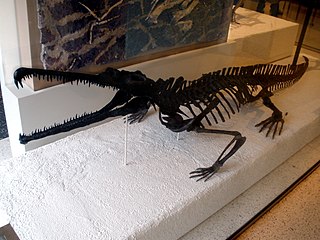
Rutiodon is an extinct genus of mystriosuchine phytosaurs from the Late Triassic of the eastern United States. The type species of Rutiodon, Rutiodon carolinensis, encompasses a large number of skulls and assorted postcranial fossils discovered in the Cumnock Formation of North Carolina. Fossils referable to the species are also known from Pennsylvania, New Jersey, and Virginia. Rutiodon carolinensis is the most well-described species of phytosaur in eastern North America, though its validity as a natural taxon has been questioned. Some paleontologists also recognize a larger and more robust species, Rutiodon manhattanensis, which is known from teeth and postcranial fossils from New Jersey and Pennsylvania.

Weigeltisaurus is an extinct genus of weigeltisaurid reptile from the Late Permian Kupferschiefer of Germany and Marl Slate of England. It has a single species, originally named as Palaechamaeleo jaekeli in 1930 and later assigned the name Weigeltisaurus jaekeli in 1939, when it was revealed that Palaeochamaeleo was a preoccupied name. A 1987 review by Evans and Haubold later lumped Weigeltisaurus jaekeli under Coelurosauravus as a second species of that genus. A 2015 reassessment of skull morphology study substantiated the validity of Weigeltisaurus and subsequent authors have used this genus. Like other Weigeltisaurids, they possessed long rod-like bones that radiated from the trunk that were likely used to support membranes used for gliding, similar to extant Draco lizards.

Xianglong is a genus of Cretaceous lizard discovered in the Zhuanchengzi, near Yizhou, Yixian, Liaoning Province of China. It is known from LPM 000666, a single complete skeleton with skin impressions. The specimen comes from the Barremian-age Lower Cretaceous Yixian Formation, near Yizhou. The most notable feature about Xianglong is its bizarre oversized ribs, eight on each side, which were attached to a membrane of body tissue and allowed the lizard to glide. While in its original description it was considered to acrodont lizard, with a cladistic analysis in the same study suggesting that it was grouped with iguanians such as agamines, chamaeleonids, and leiolepidines, it was later shown that this was due to misinterpretation of the crushed skull, and its affinities with other lizards remains uncertain.

Mecistotrachelos is an extinct genus of gliding reptile from the Late Triassic of Virginia. It is generally interpreted as an archosauromorph, distantly related to crocodylians and dinosaurs. The type and only known species is M. apeoros. This specific name translates to "soaring longest neck", in reference to its gliding habits and long neck. This superficially lizard-like animal was able to spread its lengthened ribs and glide on wing-like membranes. Mecistotrachelos had a much longer neck than other gliding reptiles of the Triassic such as Icarosaurus and Kuehneosaurus. It was probably an arboreal insectivore.
Rhabdopelix is a dubious genus of possible kuehneosaurid reptile, from the Late Triassic-age Lockatong Formation of Pennsylvania, United States. Based on partial, possibly chimeric remains, it was described by American naturalist and paleontologist Edward Drinker Cope as an early pterosaur. It held this status until the 1960s, when Ned Colbert reevaluated it for his description of Icarosaurus. He noted that the bones came from a block with the remains of other animals, and that Cope had misinterpreted some of the remains; for example, the rod-like "pubic bones" that had given it its name were actually much more like the bony structures used by Icarosaurus and related animals to glide. Additionally, he couldn't relocate the fossils, which are assumed to be lost. He recommended considering Rhabdopelix a dubious name. Peter Wellnhofer retained it as a pterosaur of unknown affinities in his 1978 review, but rejected this by 1991.
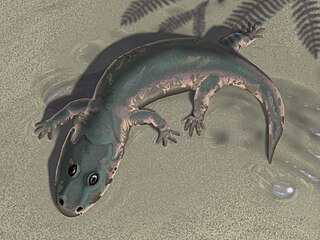
Cryobatrachus is an extinct genus of temnospondyl amphibian from the Early Triassic of Antarctica. The type species is Cryobatrachus kitchingi. It is known from a partial skull and an imprint of the skull roof, both found in the Fremouw Formation of the Transantarctic Mountains at about 85° south latitude and described in 1974. Many small bone fragments have also been identified, although they cannot be attributed with certainty to C. kitchingi. Cryobatrachus has been classified in the family Lydekkerinidae, as it is similar in appearance to the genus Lydekkerina from South Africa. Because only a small number of features distinguish it from other lydekkerinids, Cryobatrachus kitchingi has more recently been considered a nomen dubium, meaning that its distinction from other better-known species may be unwarranted.
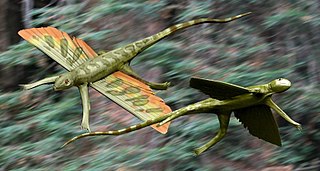
Kuehneosauridae is an extinct family of small, lizard-like gliding diapsids known from the Triassic period of Europe and North America.
The Triassic Lockatong Formation is a mapped bedrock unit in Pennsylvania, New Jersey, and New York. It is named after the Lockatong Creek in Hunterdon County, New Jersey.
Parrishia is an extinct genus of sphenosuchian crocodylomorph known from the Late Triassic Chinle, Dockum, and Santa Rosa Formations in Arizona and New Mexico.

Edwin Harris "Ned" Colbert was a distinguished American vertebrate paleontologist and prolific researcher and author.

Prolacerta is a genus of archosauromorph from the lower Triassic of South Africa and Antarctica. The only known species is Prolacerta broomi. The generic name Prolacerta is derived from Latin meaning “before lizard” and its species name broomi is in commemoration of the famous paleontologist Robert Broom, who discovered and studied many of the fossils found in rocks of the Karoo Supergroup. When first discovered, Prolacerta was considered to be ancestral to modern lizards, scientifically known as lacertilians. However, a study by Gow (1975) instead found that it shared more similarities with the lineage that would lead to archosaurs such as crocodilians and dinosaurs. Prolacerta is considered by modern paleontologists to be among the closest relatives of the Archosauriformes.
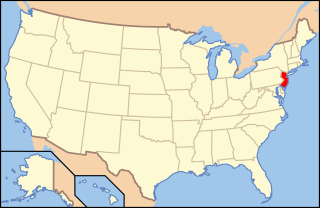
Paleontology in New Jersey refers to paleontological research in the U.S. state of New Jersey. The state is especially rich in marine deposits.
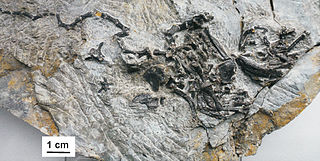
Pappochelys is an extinct genus of diapsid reptile possibly related to turtles. The genus contains only one species, Pappochelys rosinae, from the Middle Triassic of Germany, which was named by paleontologists Rainer Schoch and Hans-Dieter Sues in 2015. The discovery of Pappochelys provides strong support for the placement of turtles within Diapsida, a hypothesis that has long been suggested by molecular data, but never previously by the fossil record. It is morphologically intermediate between the definite stem-turtle Odontochelys from the Late Triassic of China and Eunotosaurus, a reptile from the Middle Permian of South Africa.

Sphodrosaurus is an extinct genus of basal archosauriform reptiles from the Late Triassic-aged New Oxford Formation of Pennsylvania. The type species is S. pennsylvanicus, described by Edwin Colbert in 1960. The holotype consists of a partial skeleton including the back of the skull, the vertebral column, all of the ribs, all of the hindlimbs and part of the upper forelimbs; Sphodrosaurus was originally believed to have been a member of the Procolophonidae while more recently Sphodrosaurus was believed to be a basal member of the Diapsida by most authors starting with Sues et al. (1993), or a member of the Rhynchosauria. In 2022, Ezcurra & Sues redescribed the holotype in detail and placed it in a phylogenetic analysis with other Triassic diapsid reptiles, where it was found as the basalmost doswellid.

























